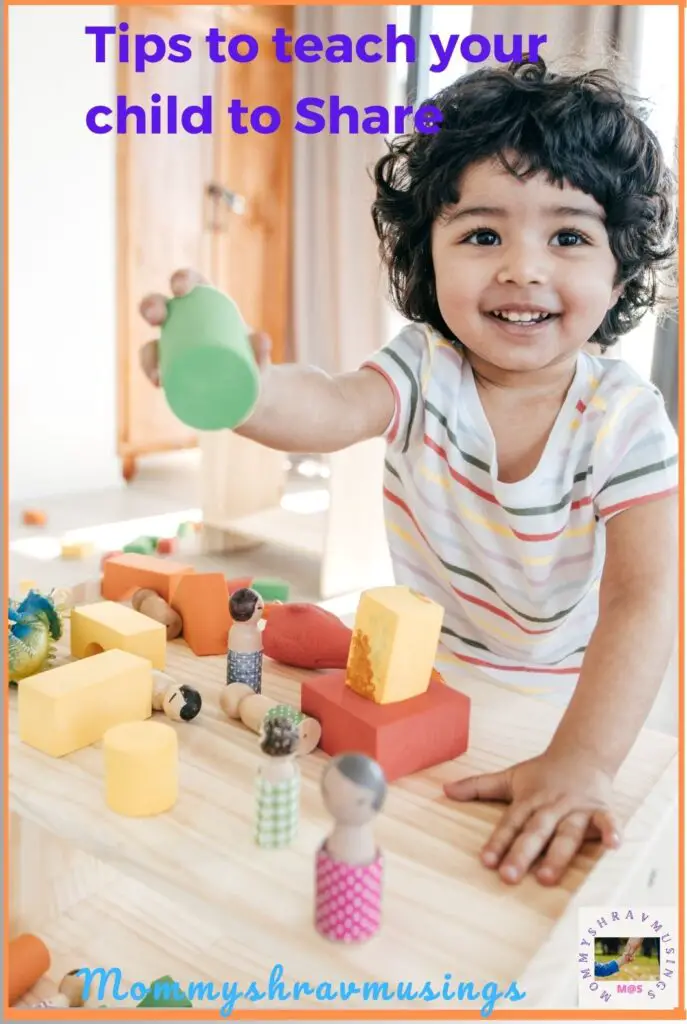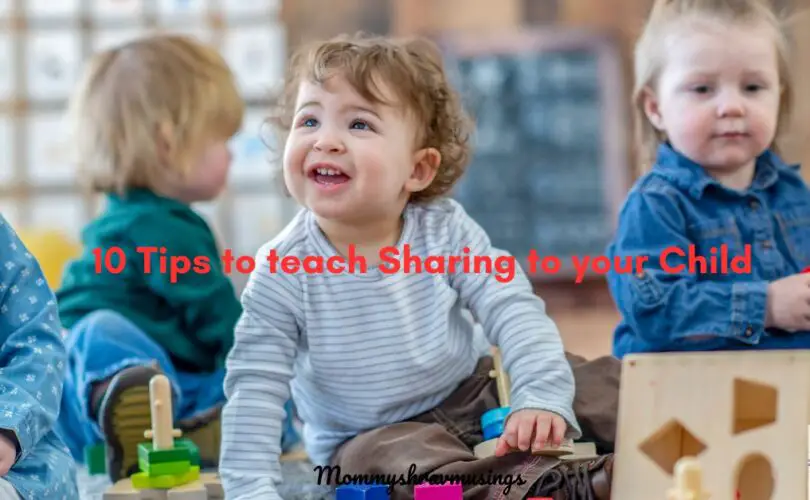Sharing is a novel concept for kids that needs to be explored and learned for toddlers and kids. When you interact with any toddler or a young kid, you would know that they use the words “it’s mines,” “it is mine,” and “no, that is mine” more frequently when compared to others.
You would have arranged a playdate with all the expectations of introducing your child to another new friend at your house. Since the room is full of toys, you would have thought there wouldn’t be a problem, but within no time, you would be taken for a ride, as both kids will start arguing using their high pitch voices about the same toy lying in a corner.

That does sound familiar. Asking your child to share or take turns is equivalent to teaching a foreign language. as those words are unfamiliar to young kids. Though it might seem daunting for parents to teach their children the importance of sharing, it can be done if we show consistency and persistence.
It’s important to note that while young children may struggle with sharing initially, it’s still valuable to introduce the concept early on. As they grow older, they will gradually develop the necessary skills and understanding to engage in sharing behaviors more consistently.
What is the right age to teach children about sharing?
The right age to start teaching children to share can vary as each child develops independently. However, sharing typically emerges around the age of two or three. At this stage, children are becoming more aware of their possessions and can understand fundamental social interactions.
Studies suggest that introducing sharing concepts at a young age, around two to three years old, can positively impact children’s sharing behaviors later on. Starting early allows for the gradual development of sharing skills over time.

As the child’s attention span is short at this stage, whatever you teach them about sharing will not last in their mind for a long time. Hence you find yourself repeating the same stuff about the importance of “sharing is caring” for them repeatedly. They might fight with another toddler for half an hour or more about a particular toy and discard that for another one in a couple of minutes. But as parents, we must teach the concepts of sharing to our children at the earliest.
Are you tired of engaging your child 24X7? Here are a few tips to cure them of their boredom and play independently.
Why it’s important to teach your child to share?
Sharing is an essential life lesson that parents must teach their children at an early age. It forms the basic foundation of social-emotional skills for children and helps them foster positive relationships in life. By learning to share, the children will:
- Get to understand the feelings and needs of others, fostering empathy and compassion.
- Start to learn and work together by taking turns. They start learning to work in teams.
- Learn how to negotiate, compromise, and find mutually acceptable solutions.
- They are likely to develop positive and lasting relationships with their peers.
- Understand the joy of giving and the happiness of making others happy.
Teaching sharing is an ongoing process that requires patience, consistency, and reinforcement, and here are some practical tips to teach your child to share easily.
Effective Ways to Teach Your Child to Share:
Here are some practical ways to encourage your child to share:
1. Lead by example: Children learn a lot from observing their parents and caregivers. Show your child how to share by sharing with them and others around you. Let them know the joy you experience while sharing with your loved ones. Sharing food and used stuff with those in need is another best example to showcase to your children.
2. Start Early: Begin teaching your child about sharing from a young age. Encourage them to share their toys, snacks, or other items with siblings, friends, or family members. You also share yours in front of them.

3. Practice turn-taking: Teach your child about taking turns and waiting for their chance to play with a particular toy or item. While passing the ball with your toddler, say, “It’s my turn to pass the ball,” and then say, “It’s your turn to pass the ball.” This helps them get familiarized with the concept of taking turns.
4. Use positive reinforcement: Praise and acknowledge your child’s efforts when they share. Positive reinforcement, such as verbal praise or small rewards, can motivate them to continue sharing in the future. You can praise their efforts in sharing, like “Look how happy Tina felt when you shared your chocolate with her” or something like that to emphasize the other person’s feelings.
5. Use storytelling: Share stories that emphasize the value of sharing and its positive outcomes. Children often connect with story characters and can better understand the lessons when they see them in action.
6. Use visual aids: For younger children, visual aids like charts or drawings can help explain sharing concepts and demonstrate turn-taking. And practice sharing with the help of elder siblings in the house so that they can learn more from their friends and siblings.
7. Organize playdates and group activities: Arrange playdates or group activities where children can practice sharing in a social setting. This provides opportunities for real-life sharing experiences with peers. You can introduce the concept of reciprocal sharing, where children take turns in sharing something they enjoy. For instance, if one child shares a toy, the other child reciprocates by sharing something of their own.
8. Introduce the “sharing jar” concept: Create a sharing jar where children can place toys or items they are willing to share. Whenever they take something out of the jar to play with, they agree to return it later or share it with others.
9. Engage in role-playing: Use role-playing scenarios to act out sharing situations and potential solutions. This interactive approach helps children practice sharing in a safe and controlled environment.
10. Address possessiveness gently: If your child exhibits possessive behavior, gently discuss how sharing can make playtime more enjoyable for everyone involved. Acknowledge their feelings while encouraging a sharing mindset.
You are not alone in your parenting journey, and here are a few snippets to motivate you.
Most Important Points to remember while teaching our Children to Share
When teaching children, especially toddlers, about sharing, parents need to keep specific critical points in mind to ensure a positive and effective learning experience
a. Be Patient and Understanding: Teaching sharing is a gradual process, and each child develops at their own pace. Avoid forcing your child to share immediately or using negative reinforcement. Be patient and understanding of their feelings, hesitations, and individual differences. Forcing them to share against their will can lead to negative associations with sharing and may cause long-term aversions.

b. Respect Boundaries: While it’s important to encourage sharing, respect your child’s boundaries and ownership of possessions. Children have a natural possessiveness over their belongings, and that’s a regular part of their development. Instead of taking things away from them abruptly, guide them gently towards sharing behaviors and emphasize the joy of giving.
c. Avoid comparing with others: Avoid comparing your child’s sharing behavior with that of other children. Instead, focus on their progress and celebrate their efforts. Don’t use labels while addressing their sharing behavior in front of others.
d. Foster Open Communication: Encourage open communication with your child about sharing experiences. Listen to their thoughts and feelings and guide them in finding solutions to sharing conflicts.
e. Set clear expectations: Establish clear guidelines for sharing. Let your child know that sharing is expected in certain situations, such as during playdates or when siblings are involved. Preparing them upfront and giving them tools like sharing jar (mentioned above), a timer, or a few additional toys will help them navigate these situations better.
This summer, you can use these jokes to better bond with your toddler and young kid.
Remember that teaching sharing is about nurturing a positive attitude towards giving and cooperation rather than merely enforcing a rule. By being patient, understanding, and setting a supportive example, parents can create a foundation for their children to develop healthy and empathetic sharing habits that will benefit them throughout their lives.
Parting Thoughts:
In the parenting journey, teaching our children the invaluable art of sharing is a cornerstone in nurturing their social and emotional growth. The lessons we impart today will ripple into their future, enriching their relationships, strengthening their sense of community, and equipping them with vital life skills. Incorporating the above effective and practical strategies into your parenting approach can teach your child to share more efficiently.
As parents, you play a significant role in modeling sharing behaviors and thus creating opportunities to teach your child to share and practice this vital life skill. Ultimately, teaching children to share extends beyond the act itself. It builds the foundation for meaningful relationships, cooperation, and conflict-resolution skills they will carry into adulthood. By investing our time, patience, and guidance, we can shape a future where our children embrace the joy of sharing and contribute to a kinder and more compassionate world.
Ask your child – “Imagine you have a special toy you love. How would you feel about sharing it with a friend or sibling? Why do you think sharing can make playtime more enjoyable?”

Suhasini, IP, is the Author of the book “Practical Tips for Kids Mental Health.” As a certified kids and parents life coach, she helps/guides you toward a happy family life for your kids. She firmly believes that “Emotionally Happy Kids of today are the Mentally Strong and Happy Citizens of tomorrow.” Let’s make the world a happy and beautiful place for our kids to thrive.







